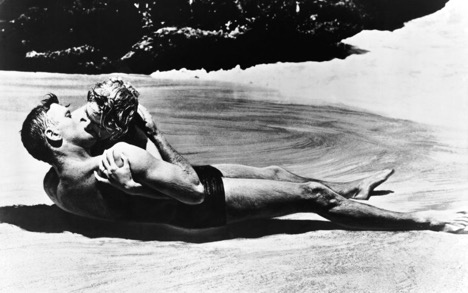
Oh, the romance. From Here To Eternity (1953) Photo courtesy: Columbia Pictures
Five Story Hacks From Classic Movies
Every screenwriter on Earth wishes he or she could create a character like Rick Blaine from Casablanca or a love story like From Here To Eternity. Classic movies may not have a lot of explosions or crazy car chases, but they still keep audiences nailed to their seats. So: how do they do it? What makes their stories so romantic, funny, heartrending or frightening? Why have these movies stood the test of time?
Let’s reverse engineer a few of the greatest films of all time to see if we can come up with some story hacks. If you’re studying the art of filmmaking, why not learn from the best?
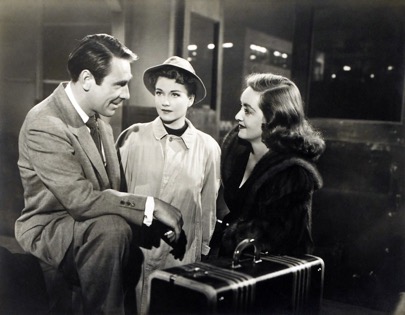
All About Eve (1950) Photo Courtesy: 20th Century Fox
No. 1 — Be Audacious
Eve Harrington (played by Anne Baxter) in All About Eve is one of the most memorable characters ever committed to film. She has a singular obsession: she wants to take over the life of Margo Channing (played by Bette Davis). The power of Eve’s obsession allows her to manipulate and control everyone around her, including Margo. What’s truly frightening about Eve is her audacity–she’s willing to do almost anything to get what she wants–and it’s exactly what makes her so memorable as a character.

Oh, mama! Psycho (1960) Photo courtesy: Paramount
No. 2 – Keep It Personal
Horror movies are a staple at the box office. One of the best ever made is Hitchcock’s Psycho. As screenwriters, we’re often tempted to write explosions and car chases and over-the-top stakes into our scripts to attract attention, but this movie shows that horror doesn’t need to be gory or sadistic. In fact, the most terrifying part of this movie is the extremely personal nature of Norman Bates’ motives. In this movies, horror is deep, intense–and terrifyingly intimate.
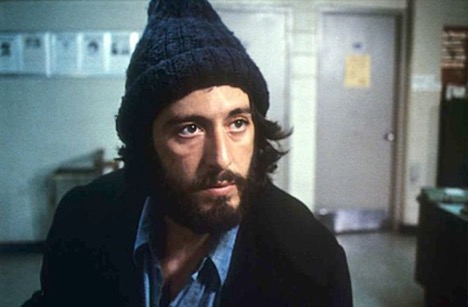
Al Pacino in Serpico (1973) Photo courtesy: Paramount Pictures
No. 3 – Make Your Hero Do The Wrong Thing For The Right Reasons
Modern classic Serpico tells the story of a cop who goes undercover to expose corruption in the police force. Even though everyone he knows warns him that he’s taking things too far, Serpico (Al Pacino) doggedly refuses to give up his investigation. He relentlessly pursues truth even after it becomes the wrong thing to do. The result is a complex, dynamic, and truly unforgettable character.
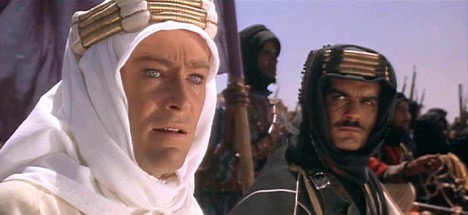
Lawrence of Arabia (1962) Photo courtesy: Columbia Pictures
No. 4 – Make It Epic
Audiences enjoy watching historical figures on screen, and they enjoy feeling like the characters they’re watching had an impact. They want their stories to matter. T. E. Lawrence (played by Peter O’Toole) in Lawrence of Arabia is one of those amazing characters. In this movie, he literally changes the world by convincing the Arabs to take up arms against the Ottoman Empire. The film is epic in every way: it takes us from wind-blown sandy deserts to grand battles, and it offers us a character who truly mattered.
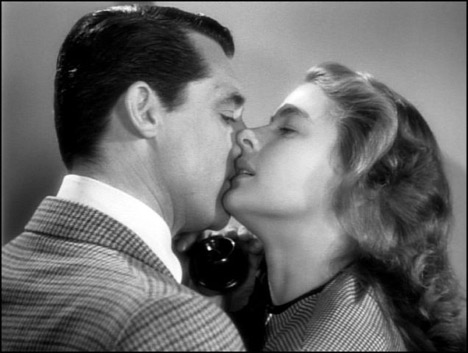
That kiss, though… Notorious (1946) Photo courtesy: RKO Pictures
No. 5 – Make It Artistic
Human beings have always felt the desire to express themselves, beginning with cave drawings of buffalo. Art answers a fundamental human need, and classic movies are an expression of that need. Of course, not all classics are artistic, per se, but all classics include some form of art. It could be provocative dialogue, or a heartrending storyline, or visually poetic scenery, or, as in the case of Notorious, exquisite characters.
Screenwriter Ben Hecht paints the suffering of Alicia (Ingrid Bergman) as she’s drawn into a deadly love triangle in extraordinary detail–and it’s part of the reason why the movie made it into the National Film Registry for being “culturally, historically, or aesthetically significant.” So go ahead and use cinema to express your artistic side, if you wish. We humans need your art.




8 Replies to "What Can We Learn From Classic Movies? Pretty Much Everything"
Frank Martin June 22, 2016 (2:41 am)
Amen!
PI Barrington June 22, 2016 (4:39 am)
I agree wholeheartedly! I’ve been nailed to movies like those you mentioned since I was a child!
Martin L Grayson June 22, 2016 (5:03 am)
You say Serpico “relentlessly pursues truth even after it becomes the wrong thing to do.”
I don’t see how it was ever the “wrong” thing to do. It may have been the dangerous thing to do. . . .
Jennie Evenson June 22, 2016 (4:22 pm)
You’re right — it’s probably better to describe it as “complicated.” It’s a complicated decision to pursue the truth even after the pursuit becomes a danger to yourself and others, in my opinion. Other people interpret the film differently, of course, but I believe the film intends to show us decisions that are a complicated mix of right and wrong. Another film that manages to dramatize this sort of complexity is “Donnie Brasco.”
GK Noyer June 22, 2016 (2:35 pm)
The problem is, every one of these films would be rejected today by the execs and deciders (if they hadn’t already been made, I mean obviously). They don’t fit the
cookie-cutter recipes being imposed on every one these days, like Snyder’s Beat Sheet or what have you. Seriously, can you imagine getting anyone to even read Lawrence of Arabia today – 187 mns in its shortest version? (228 mns in its longest) Good luck with that!
Tony June 23, 2016 (9:00 am)
You’re not remaking the films though. You’re taking their brains, the beating heart, the lungs, the stomach, a bit of their skin, (not the appendix), of what makes them great and (hopefully) bringing it into your written world to make it better. Expanding the cookie-cutter a little bit more.
Theresa June 22, 2016 (11:50 pm)
Classic movies (especially the black and white films) are where my inspiration comes from.
Mark M June 23, 2016 (5:43 pm)
In Lawrence Kasdan’s near perfect film, Grand Canyon (20th Century Fox, 1991), Steve Martin’s character (Davis) tells Kevin Kline (Mack), “…part of your problem, you know, you haven’t seen enough movies. All of life’s riddles are answered in the movies.”
This is more than just a cleverly-delivered sarcastic line uttered by a self-made egoist. It’s a statement of fact. Filmdom has conquered nearly every genre imaginable to the point that the industry is left to shamefully regurgitate pre-existing storylines. Film makers by now should be on the verge of a movie renaissance of sorts. An individual cannot honestly refer to her or himself as a movie fan unless they can cite examples from classic cinema; Citizen Kane, Casablanca, whatever…
My point is that classic movies do not let us down no matter how many times we watch them. They resonate within us because they actually have something worthwhile to say; something about relationships, how we navigate our experiences and how we become [hopefully] better versions of ourselves; a premise that Transformers, all super-hero movies and the like routinely and perpetually fail to deliver upon. They’re just so ridiculously audacious and over-the-top; pure escapist nonsense. But, that seems to be what the movie-going public wants these days and it only serves to reinforce the prevalence of “extended adolescence” that has become so pervasive throughout society. Most classic movies aimed to elicit some kind of cathartic response from viewers, however small or great. Catharsis as a state of mind or experience perceived as valuable is largely shunned or avoided now, replaced by events and activities (movies included) that have a mind-numbing effect.
Pixar save us!!